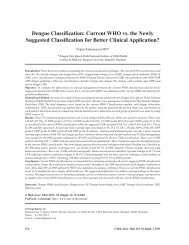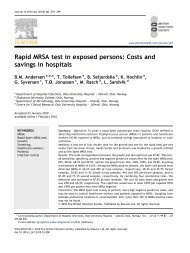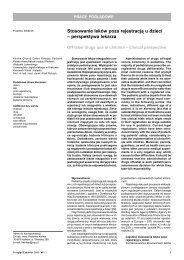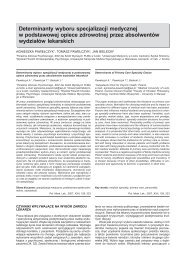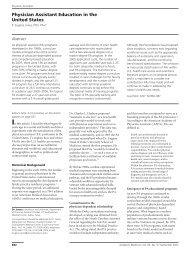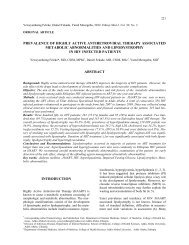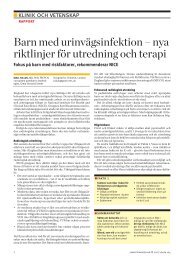Assessment of the quality of life in patients with oral ... - Labome.Org
Assessment of the quality of life in patients with oral ... - Labome.Org
Assessment of the quality of life in patients with oral ... - Labome.Org
You also want an ePaper? Increase the reach of your titles
YUMPU automatically turns print PDFs into web optimized ePapers that Google loves.
<strong>Assessment</strong> <strong>of</strong> <strong>the</strong> <strong>quality</strong> <strong>of</strong> <strong>life</strong> <strong>in</strong> <strong>patients</strong> <strong>with</strong> <strong>oral</strong><br />
cavity and jaw cancer <strong>in</strong> three regions <strong>of</strong> Bulgaria<br />
Maria Stoikova<br />
Department <strong>of</strong> Social Medic<strong>in</strong>e and Medical Management, Medical University, Plovdiv,<br />
Bulgaria<br />
Author and address for correspondence:<br />
Maria Stoikova, MD<br />
Department <strong>of</strong> Social Medic<strong>in</strong>e and Medical Management, Faculty <strong>of</strong> Medic<strong>in</strong>e<br />
Medical University – Plovdiv<br />
15A Vasil Aprilov Blvd<br />
Plovdiv 4000<br />
Bulgaria<br />
Fax: +359 32 602 534<br />
E-mail: brami@abv.bg<br />
Summary<br />
Purpose: The aim <strong>of</strong> <strong>the</strong> present study was to assess <strong>the</strong> <strong>quality</strong> <strong>of</strong> <strong>life</strong> <strong>in</strong> <strong>patients</strong> <strong>with</strong><br />
<strong>oral</strong> cavity and jaw cancer, us<strong>in</strong>g an orig<strong>in</strong>al rat<strong>in</strong>g scale.
Materials and methods: In order to assess <strong>the</strong> <strong>quality</strong> <strong>of</strong> <strong>life</strong> <strong>in</strong> such <strong>patients</strong> an<br />
orig<strong>in</strong>al rat<strong>in</strong>g scale was developed. It was validated. Non-parametrical analysis, Van der<br />
Waerden analysis for small samples and graphic analysis were used for statistics.<br />
Results: Results showed that most <strong>patients</strong> were rated as grade III or IV accord<strong>in</strong>g to<br />
<strong>the</strong> five grade scale. Their <strong>life</strong> <strong>quality</strong> was significantly reduced, result<strong>in</strong>g <strong>in</strong> depression and<br />
despair. Reconstruction and pros<strong>the</strong>sis implantation and social rehabilitation were needed <strong>in</strong><br />
<strong>the</strong>se <strong>patients</strong>. Quality <strong>of</strong> <strong>life</strong> was assessed <strong>in</strong> 19 <strong>patients</strong> prior to and follow<strong>in</strong>g pros<strong>the</strong>sis<br />
implantation. Prior to implantation most <strong>patients</strong> were rated as grade III or IV, whereas <strong>the</strong><br />
majority <strong>of</strong> <strong>the</strong>m were rated as grade 0 or 1 follow<strong>in</strong>g pros<strong>the</strong>sis implantation.<br />
Conclusion: After assessment <strong>of</strong> <strong>life</strong> <strong>quality</strong>, <strong>patients</strong> rated as grade III or IV should<br />
be allowed access to complex medical management, <strong>in</strong>clud<strong>in</strong>g pros<strong>the</strong>sis implantation and<br />
social rehabilitation.<br />
Key words: rat<strong>in</strong>g scale, <strong>quality</strong> <strong>of</strong> <strong>life</strong>, pros<strong>the</strong>sis<br />
Introduction<br />
A number <strong>of</strong> module questionnaires and rat<strong>in</strong>g scales have been used <strong>in</strong> an attempt to<br />
assess <strong>the</strong> <strong>quality</strong> <strong>of</strong> <strong>life</strong> <strong>in</strong> <strong>patients</strong> <strong>with</strong> <strong>oral</strong> cavity and jaw cancer. Specific for defect<br />
location as well as unspecific rat<strong>in</strong>g <strong>in</strong>struments have been applied – Head & Neck Cancer<br />
Modul, VFQ [5,13,17]. Most <strong>of</strong> <strong>the</strong>m focus on health problems, functional impairment and<br />
depression as a result <strong>of</strong> disfigurement [1,2,5,6,7,8,9,12,14,15,16,17,18]. Some authors<br />
consider <strong>the</strong>m detailed and labor consum<strong>in</strong>g – <strong>in</strong> J. Kollbruner’s et al. op<strong>in</strong>ion, <strong>the</strong> scales <strong>the</strong>y<br />
used, consisted <strong>of</strong> 241 test items and 19 <strong>life</strong> <strong>quality</strong> aspects and thus was difficult to apply<br />
[11]. A number <strong>of</strong> authors developed <strong>the</strong>ir own rat<strong>in</strong>g scales – Schleiphake et al. used a<br />
standardized scale, consist<strong>in</strong>g <strong>of</strong> 22 test items [15]. A new, easy to use rat<strong>in</strong>g scale to assess<br />
<strong>the</strong> <strong>quality</strong> <strong>of</strong> <strong>life</strong> <strong>in</strong> <strong>patients</strong> <strong>with</strong> <strong>oral</strong> cavity and jaw cancer is presented <strong>in</strong> this study.
Material and methods<br />
The aim <strong>of</strong> <strong>the</strong> present study was to assess <strong>the</strong> <strong>quality</strong> <strong>of</strong> <strong>life</strong> <strong>in</strong> <strong>patients</strong> <strong>with</strong> <strong>oral</strong><br />
cavity and jaw cancer. An <strong>in</strong>terview was adm<strong>in</strong>istered to 103 <strong>patients</strong> from Plovdiv, Smolyan<br />
and Pazarjik region (Bulgaria). All <strong>of</strong> <strong>the</strong>m presented <strong>with</strong> <strong>oral</strong> cavity and jaw cancer (141-<br />
145;170.0;170.1, accord<strong>in</strong>g to <strong>the</strong> International Classification <strong>of</strong> Diseases ICD - 9). Lip<br />
cancer was excluded.<br />
In this study an orig<strong>in</strong>ally developed, (not a standard) rat<strong>in</strong>g scale <strong>of</strong> <strong>quality</strong> <strong>of</strong> <strong>life</strong><br />
was used. It was developed, based on evaluation and analysis <strong>of</strong> functional impairment <strong>in</strong><br />
such <strong>patients</strong>. The scale was validated <strong>in</strong> a pilot study <strong>of</strong> 30 <strong>patients</strong>, yield<strong>in</strong>g a very good<br />
value <strong>of</strong> Cronbach’s alpha coefficient – α = 0.91. External validity was assessed, compar<strong>in</strong>g<br />
rat<strong>in</strong>gs by two <strong>in</strong>dependent scorers – <strong>the</strong> researcher and a dentist, perform<strong>in</strong>g pros<strong>the</strong>sis<br />
implantation <strong>in</strong> <strong>the</strong> oro-facial region. N<strong>in</strong>eteen <strong>patients</strong> were evaluated. Results showed a high<br />
correlation – p
Figure 1. <strong>Assessment</strong> <strong>of</strong> <strong>quality</strong> <strong>of</strong> <strong>life</strong> <strong>in</strong> <strong>the</strong> <strong>patients</strong>, studied.<br />
Results showed that most <strong>patients</strong> were rated as grade 3(65.05±4.69) or<br />
4(22.33±4.10). They had impaired speak<strong>in</strong>g and feed<strong>in</strong>g, comb<strong>in</strong>ed <strong>with</strong> disfigurement and<br />
pa<strong>in</strong> or both. Functional impairment <strong>in</strong> such <strong>patients</strong> is severe, lead<strong>in</strong>g to despair and<br />
depression and no faith <strong>in</strong> favorable outcome. O<strong>the</strong>r authors’ studies present similar results<br />
[3,10]. Multiple surgical <strong>in</strong>terventions - re-operations and pros<strong>the</strong>sis implantation are <strong>the</strong> only<br />
option <strong>in</strong> such <strong>patients</strong>, as an element <strong>of</strong> social rehabilitation [4].<br />
Prior to analyz<strong>in</strong>g <strong>the</strong> role <strong>of</strong> pros<strong>the</strong>sis implantation, <strong>the</strong> <strong>quality</strong> <strong>of</strong> <strong>life</strong> <strong>of</strong> <strong>the</strong>se<br />
<strong>patients</strong> was rated accord<strong>in</strong>g to <strong>the</strong> disease stage (Figure 2).<br />
70<br />
60<br />
50<br />
40<br />
30<br />
20<br />
10<br />
0<br />
%<br />
0 grade 1st grade 2nd grade 3rd grade 4th grade<br />
I and II dis.stage<br />
III and IV dis.stage<br />
Figure 2. <strong>Assessment</strong> <strong>of</strong> <strong>quality</strong> <strong>of</strong> <strong>life</strong> accord<strong>in</strong>g to disease stage.<br />
Results show that most <strong>patients</strong> were rated as grade 3 or 4. Significantly reduced<br />
<strong>quality</strong> <strong>of</strong> <strong>life</strong> (grade 3) was reported by most <strong>patients</strong> <strong>in</strong> stage I or II <strong>of</strong> <strong>the</strong> disease. Severely<br />
reduced <strong>life</strong> <strong>quality</strong> (grade 4) was reported by a nearly equal number <strong>of</strong> <strong>patients</strong> from both<br />
groups – about 20 % <strong>in</strong> stage I and II <strong>of</strong> <strong>the</strong> disease and <strong>in</strong> stage III or IV <strong>of</strong> <strong>the</strong> disease. This<br />
is due to <strong>the</strong> fact that <strong>patients</strong> <strong>with</strong> stage I or II receive surgical treatment, which <strong>in</strong> stage II is
followed by radio<strong>the</strong>rapy. Stage III <strong>patients</strong> receive only radio<strong>the</strong>rapy, stage IV- radio<strong>the</strong>rapy<br />
and chemo<strong>the</strong>rapy. This treatment strategy significantly impairs normal function<strong>in</strong>g even <strong>in</strong><br />
stage I and causes severe patient’s discomfort. Thus, all <strong>patients</strong> <strong>with</strong> <strong>oral</strong> cavity cancer have<br />
a reduced <strong>quality</strong> <strong>of</strong> <strong>life</strong> regardless <strong>of</strong> <strong>the</strong> disease stage and need complex treatment by a team<br />
<strong>of</strong> specialists – <strong>the</strong> so called social rehabilitation.<br />
In order to prove that pros<strong>the</strong>sis implantation improves <strong>the</strong><br />
<strong>quality</strong> <strong>of</strong> <strong>life</strong> such<br />
<strong>patients</strong>, <strong>the</strong>y were rated us<strong>in</strong>g <strong>the</strong> scale prior to and follow<strong>in</strong>g reconstruction (Figure 3).<br />
%<br />
80<br />
70<br />
60<br />
50<br />
40<br />
30<br />
20<br />
10<br />
0<br />
0 grade 1st grade 2nd grade 3rd grade 4th grade<br />
prior to proth. Inplant.<br />
follow<strong>in</strong>g proth. Inplant.<br />
Figure 3. The <strong>quality</strong> <strong>of</strong> <strong>life</strong> <strong>of</strong> <strong>patients</strong> before to pros<strong>the</strong>sis implantation and after<br />
pros<strong>the</strong>sis<br />
implantation.<br />
The date show that <strong>the</strong>re is a significant difference, regard<strong>in</strong>g <strong>quality</strong> <strong>of</strong> <strong>life</strong> prior to<br />
and follow<strong>in</strong>g pros<strong>the</strong>sis implantation. Before pros<strong>the</strong>sis implantation most <strong>patients</strong> were<br />
rated as hav<strong>in</strong>g reduced <strong>quality</strong> <strong>of</strong> <strong>life</strong> (grade 3 or 4). After implantation most <strong>of</strong> <strong>the</strong>m were<br />
rated as grade 0 or 1, <strong>in</strong>dicat<strong>in</strong>g that problems <strong>with</strong> speak<strong>in</strong>g, feed<strong>in</strong>g, disfigurement and pa<strong>in</strong><br />
have been elim<strong>in</strong>ated. The difference between <strong>the</strong> two groups is statistically significant<br />
p
small samples was used ( Table 1). Table 1 shows <strong>the</strong> proportion <strong>of</strong> <strong>patients</strong> rated as grade 0<br />
and 1 prior to pros<strong>the</strong>sis implantation and rated as grade 3 or 4 follow<strong>in</strong>g implantation. The<br />
difference is statistically significant.<br />
The results <strong>of</strong> <strong>the</strong> study illustrate <strong>the</strong> need <strong>of</strong> pros<strong>the</strong>sis implantation <strong>in</strong> <strong>patients</strong> <strong>with</strong><br />
large maxillo-facial defects. Apart from <strong>the</strong> improved sense <strong>of</strong> well –be<strong>in</strong>g and recovery <strong>of</strong><br />
vital functions, it is also a contribut<strong>in</strong>g factor to <strong>patients</strong>’ cop<strong>in</strong>g <strong>with</strong> <strong>the</strong> illness. Most<br />
authors consider cop<strong>in</strong>g structure crucial to <strong>patients</strong>’ illness management [4]. It is necessary<br />
<strong>in</strong> such <strong>patients</strong> after assessment <strong>of</strong> <strong>quality</strong> <strong>of</strong> <strong>life</strong>, those rated as grade 3 rd or 4 th grade to<br />
receive adequate medical care and social rehabilitation.<br />
Conclusions<br />
1. Patients <strong>with</strong> <strong>oral</strong> cavity and jaw cancer have a reduced <strong>quality</strong> <strong>of</strong> <strong>life</strong> regardless <strong>of</strong><br />
disease stage and require complex management by a team <strong>of</strong> specialists.<br />
2. Pros<strong>the</strong>sis implantation improves <strong>quality</strong> <strong>of</strong> <strong>life</strong> <strong>in</strong> <strong>patients</strong> <strong>with</strong> <strong>oral</strong> cavity and jaw<br />
cancer.<br />
3. This scale is easy to use and could be applied as a <strong>quality</strong> <strong>of</strong> <strong>life</strong> assessment<br />
<strong>in</strong>strument <strong>in</strong> Cl<strong>in</strong>ics <strong>of</strong> Oro-facial Surgery. This would facilitate postoperative care<br />
and social rehabilitation <strong>of</strong> such <strong>patients</strong>.
References<br />
1. Bocca M, Pomatto E, Sa<strong>in</strong>i P et al. Evaluation <strong>of</strong> psychological disorders <strong>in</strong> <strong>patients</strong><br />
<strong>with</strong> cancer <strong>of</strong> <strong>the</strong> <strong>oral</strong> cavity. M<strong>in</strong>erva Stomatol 1999;48 (5):209-216<br />
2. Chaturvedi S K, Shenoy A, Prasad KM et al. Concerns cop<strong>in</strong>g and <strong>quality</strong> <strong>of</strong> <strong>life</strong> <strong>in</strong><br />
head and neck cancer <strong>patients</strong>. Support Care Cancer 1996; 4(3):186-190<br />
3. Crossley ML. ‘Let me expla<strong>in</strong> narrative employment and one patient’s experience <strong>of</strong><br />
<strong>oral</strong> cancer. Social science & Medic<strong>in</strong>e 2003;56(3):439-448<br />
4. De Boer M, Mc Cornick L, Pruyn J et al. Physical and psychosocial correlates <strong>of</strong> head<br />
and neck cancer: a review <strong>of</strong> <strong>the</strong> literature. Otolaryngol Head Neck Surg<br />
1999;120:427-436<br />
5. De Graeff A, de Leeuw J, Ros W et al. A prospective study on <strong>quality</strong> <strong>of</strong> <strong>life</strong> <strong>of</strong><br />
<strong>patients</strong> <strong>with</strong> cancer <strong>of</strong> <strong>the</strong> <strong>oral</strong> cavity or oropharynx treated <strong>with</strong> surgery <strong>with</strong> or<br />
<strong>with</strong>out radio<strong>the</strong>rapy. Oral Oncol 1999;35(1):27-32<br />
6. De Graeff A, de Leeuw J, Ros W et al. A prospective study on <strong>quality</strong> <strong>of</strong> <strong>life</strong> <strong>of</strong><br />
laryngeal cancer <strong>patients</strong> treated <strong>with</strong> radio<strong>the</strong>rapy. Head& Neck 1999;21(4):291-296<br />
7. Epste<strong>in</strong> JB, Emerton S, Kolb<strong>in</strong>son PA et al. Quality <strong>of</strong> <strong>life</strong> and <strong>oral</strong> function follow<strong>in</strong>g<br />
radio<strong>the</strong>rapy for head and neck cancer. Head& Neck 1999; 21(1):1-11<br />
8. Gritz E, Carmack C, de Moor C et al. First year after head and neck cancer; <strong>quality</strong> <strong>of</strong><br />
<strong>life</strong>. J Cl<strong>in</strong> Oncol 1999;17(11):352-360<br />
9. Hammerlid E, Bjordal K, Ahlner – Elmqvist M et al. Prospective longitud<strong>in</strong>al <strong>quality</strong><br />
<strong>of</strong> <strong>life</strong> study <strong>of</strong> <strong>patients</strong> <strong>with</strong> head and neck cancer: a feasibility study <strong>in</strong>clud<strong>in</strong>g <strong>the</strong><br />
EORTC QLQ C 30. Otolaryngol Head Neck Surg 1997;116 (6 Pt1):666-673
10. Hassane<strong>in</strong> K, Musgrove B, Bradbury E. Functional status <strong>of</strong> <strong>patients</strong> <strong>with</strong> <strong>oral</strong> cancer<br />
and its relation to style <strong>of</strong> cop<strong>in</strong>g, social support and psychological status. British<br />
Journal <strong>of</strong> Oral & Maxill<strong>of</strong>acial Surgery 2001;39(5):340-345<br />
11. Kollbrunner J, Zbaren P, Quack K. Quality <strong>of</strong> <strong>life</strong> stress <strong>in</strong> <strong>patients</strong> <strong>with</strong> larger tumors<br />
<strong>of</strong> <strong>the</strong> mouth. A descriptive study <strong>of</strong> psychosocial effects <strong>of</strong> illness and primary<br />
surgery <strong>the</strong>rapy <strong>in</strong> 3 parts – 1: Quality and Quality <strong>of</strong> <strong>life</strong>; HNO 2001;49(12):985-987<br />
12. Kornblith A, Zlotolow I, Gooen J et al. Quality <strong>of</strong> <strong>life</strong> <strong>of</strong> maxillectomy <strong>patients</strong> us<strong>in</strong>g<br />
an obturator pros<strong>the</strong>sis. Head&Neck 1996;18(4):323-334<br />
13. Lovely M, Miaskowski C, Dodd M. Relationship between fatique and <strong>quality</strong> <strong>of</strong> <strong>life</strong> <strong>in</strong><br />
<strong>patients</strong> <strong>with</strong> glioblastoma multiformae. Oncol Nurs Forum 1999;26(5):921-925<br />
14. Moore G, Parsons J, Mendenhall W. Quality <strong>of</strong> <strong>life</strong> outcomes after primary<br />
radio<strong>the</strong>rapy for squamous cell carc<strong>in</strong>oma <strong>of</strong> <strong>the</strong> base <strong>of</strong> tongue. Int J Radiat Oncol<br />
Biol Phys 1996;36(2):351-354<br />
15. Schliephake H, Ruffert K, Schneller T. Prospective study <strong>of</strong> <strong>the</strong> <strong>quality</strong> <strong>of</strong> <strong>life</strong> <strong>of</strong><br />
cancer <strong>patients</strong> after <strong>in</strong>tra<strong>oral</strong> tumor surgery. J Oral Maxill<strong>of</strong>ac Surg 1996;54(6):664-<br />
669; discussion 669-670<br />
16. Weitzner M, Mc Millan S. The Caregiver Quality <strong>of</strong> Life Index – Cancer (CQOLC)<br />
Scale: revalidation <strong>in</strong> a home hospice sett<strong>in</strong>g. J Palliat Care 1999;15(2):13-20<br />
17. Zelefsky M, Gaynor J, Kraus D et al. Longterm subjective functional outcome <strong>of</strong><br />
surgery plus postoperative radio<strong>the</strong>rapy for advanced stage <strong>oral</strong> cavity and<br />
oropharyngeal carc<strong>in</strong>oma. Am J Surg 1996;171(2):258-261<br />
18. Zitton R, Achard S, Ruszniewski M. <strong>Assessment</strong> <strong>of</strong> <strong>quality</strong> <strong>of</strong> <strong>life</strong> dur<strong>in</strong>g <strong>in</strong>tensive<br />
chemo<strong>the</strong>rapy or bone marrow transplantation. Psychooncology 1999;8(1):64-73
Table 1. <strong>Assessment</strong> <strong>of</strong> <strong>quality</strong> <strong>of</strong> <strong>life</strong> prior to and follow<strong>in</strong>g pros<strong>the</strong>sis implantation <strong>in</strong> 19<br />
<strong>patients</strong><br />
Grade Prior to pros<strong>the</strong>sis implantation Follow<strong>in</strong>g pros<strong>the</strong>sis<br />
implantation<br />
number % Sp number % Sp<br />
0 0 4,76 4,54 15 76,19 9,08<br />
1 st 0 4,76 4,54 3 19,04 8,37<br />
2 nd 1 9,52 6,25 1 9,52 6,25<br />
3 rd 9 47,61 10,64 0 4,76 4,54<br />
4 th 9 47,61 10,64 0 4,76 4,54



